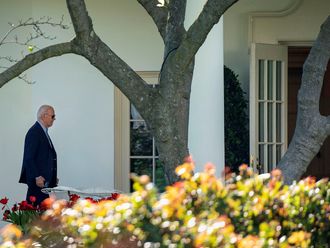Mexico City: An ID, proof of address and $40 (Dh147) is all you need to get a driver’s licence and navigate the concrete jungle of Mexico City. Who needs a road test anyway?
It can take as little as half an hour to walk out of a city government office with a licence and join the mess of seven million drivers in the metropolis of 21 million people.
Residents of the mega-capital have not needed to pass a driver’s exam since 2003, but that is about to change as the city government, fed up with the rampant traffic accidents, is cracking down on bad driving.
New traffic rules with heavier fines came into force on Tuesday, and officials plan to restore the driver’s test next year.
The rules seek to protect pedestrians and cyclists in a city where the mayhem has prompted citizens to take to the streets dressed as superheroes or wrestlers to teach drivers to be more civil.
Between two to three people die each day in traffic accidents, according to figures from Mayor Miguel Angel Mancera’s office.
“Whoever drives in Mexico City can drive anywhere in the world,” claims a local saying, though pedestrians, cyclists and other drivers who face near accidents and annoying honking each day would beg to differ.
“Most of us learn as we go, some more than others,” said Maria Teresa Ramirez, a 67-year-old government worker who stood in line this week to renew her licence.
“Some drive so fast that it looks like they’re in a hurry to collect an inheritance,” she said.
Maria, a 25-year-old Chinese woman in the same line, said she was helping her boss at a textile company get his licence because “it will be more complicated if he has to take a test” because he doesn’t speak Spanish.
The driver’s test was scrapped 12 years ago by then leftist mayor Andres Manuel Lopez Obrador, a two-time presidential candidate who argued that it would end the bribes people paid to avoid the exam.
“It was very unfortunate because there’s almost no road training in Mexico. Most drivers learned to drive by observing others, with a friend or a relative,” said Gerardo Gutierrez, director of the Imperial driving school, one of 30 registered in the city.
Only minors between the ages of 15 and 17 are required to take a driver’s test to get a licence.
Across the rest of Latin America, tests are usually required for all drivers.
The new road rules have fines ranging between $40 and $200 — a large sum in a country where the daily minimum wage is about $4.
The regulation bans turning right on red, and toughens fines for infractions such as failing to wear a seatbelt, using a cellphone while driving, exceeding the 50 kilometer per hour speed limit or laying on the horn.
To prevent corruption, the city government installed 40 surveillance cameras at key intersections to keep an eye on transit police. A smartphone app called “Mi Policia” (My Police) was created so that people can file complaints.
“It will help to avoid any digressions from officers,” the undersecretary of transit control, Fernando Martinez Badillo said.
As for drivers, while they don’t have to take a test yet, their driving will get better and accidents will drop as they realise that they will be punished “if they don’t respect the rules.”











